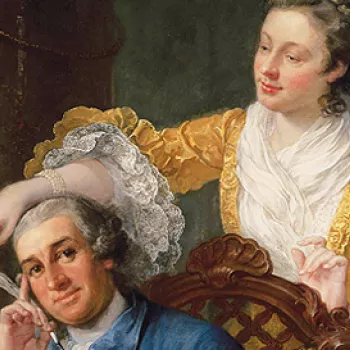Attributed to Ludolf Lafontaine (1704-74)
George I (1660-1727) c.1727-35
Watercolour on ivory | 7.3 x 5.8 cm (sight) (sight) | RCIN 420655
-
George, Elector of Hanover, was proclaimed King of Great Britain and Ireland in 1714 under the Act of Settlement which sought to secure a Protestant succession. There were at least 50 Roman Catholic relatives with stronger claims. He was challenged by the Jacobites, supporters of the Roman Catholic son of James II, James Stuart, who landed in Scotland in 1715, but the rebellion was suppressed by the end of the year. In Parliament, some Tories were sympathetic to the Jacobites so George turned to the Whig party to form a government and they dominated politics. Opposition to the King gathered round his eldest son, George, Prince of Wales, and led to differences and intense dislike between father and son. In 1719 and 1720, and during most of the King's absences in Hanover, power was delegated to a Regency Council and not to the Prince of Wales. George I married in 1682 Sophia Dorothea of Brunswick-Celle; he subsequently divorced her for infidelity and in 1694 imprisoned her in the castle of Ahlden until her death in 1726. George died on 11 June 1727 during a visit to Hanover.
Although the commission of a miniature portrait of George I during the later part of his reign would naturally have fallen to his Painter in Enamel, Bernard Lens (see no. 189) this particular miniature does not bear the hallmarks of Lens's style. It is closely related to the three-quarter-length oil portrait by Georg Wilhelm Lafontaine (1680–1745 ) in the Royal Collection (RCIN 405247), which probably dates from c.1725–7. The miniature may have been painted by Georg Wilhelm's son, Ludolf Lafontaine, who was born in Celle in 1704, was trained by his father in both oil and miniature painting, and worked in both England and Holland. He would have had access to the original oil painting in his father's studio but could conceivably have used the line engraving of 1733 by G.W. Monguibert. In 1734 Ludolf became court painter in Brunswick, where he stayed until his death in 1774.
The pared-down nature of the miniature, which omits the royal regalia seen in the oil portrait, and exchanges the Banqueting House for a plain drab background, emphasises the simplicity of presentation of the monarch. George I appears here in the sympathetic guise of an English gentleman. George I is depicted wearing a steinkirk cravat which was designed to be worn loosely or negligently. The fashion is said to have begun after troops at the battle of Steenkerque in 1692 had no time to tie their cravats properly before going into action. The steinkirk falls over the ribbon of the Order of the Garter.
Text adapted from The First Georgians: Art and Monarchy 1714-1760, London, 2014.Provenance
First recorded in the Royal Collection in 1870.
-
Creator(s)
-
Medium and techniques
Watercolour on ivory
Measurements
7.3 x 5.8 cm (sight) (sight)
8.8 x 7.3 cm (frame, external)
Category
Object type(s)
Other number(s)
RL 1870 5.A.1










